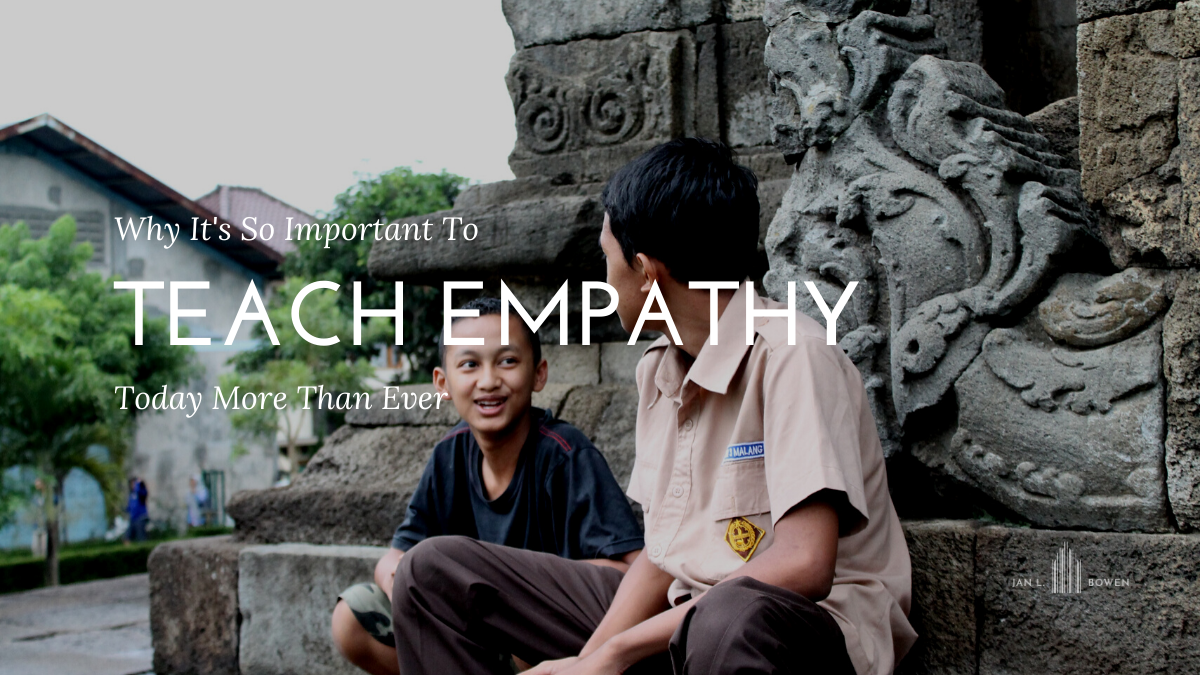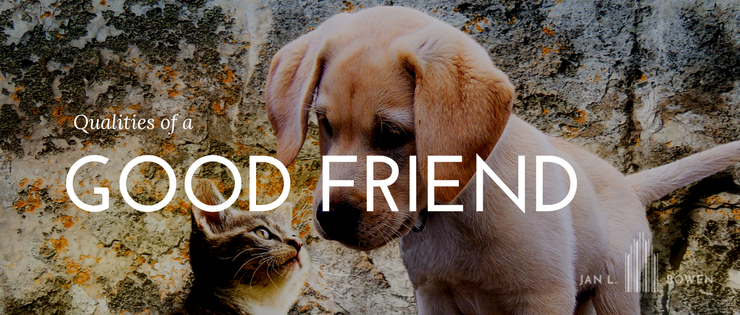We are a diverse world — diverse in culture, viewpoint, and opportunities. This diversity has a wealth of knowledge and insight. But because diversity, by definition, doesn’t always speak the same language, literally or figuratively, we overlook the vast opportunities within our world. Instead of drawing together to connect and overcome differences, polar opposite opinions divide us. Teaching — and practicing —empathy, moves us from egocentric opinions to conversing and connecting.
Empathy is a key that unlocks the opportunities within division, and simultaneously serves as a bridge to connect.
Teaching empathy expands our perspective while encouraging values of understanding, kindness, compassion, and tolerance. Practicing empathy also maintains our autonomy and integrity.
What exactly is empathy?
So, what exactly is empathy? Sometimes confused with sympathy, empathy has a unique transformative characteristic.
Empathy is the ability to experience what another individual is experiencing. It goes beyond understanding someone else’s feelings. Being empathetic is to embody the same experience as another — no matter how briefly. It can also be a route of self growth, urging us to broaden personal boundaries of experience, understanding, and acceptance.
Sympathy carries a risk of taking a shortcut. It can bypass complete understanding of another’s experience by relying on feelings solely.
The choice that leads us individually and collectively to greater unity is the one that allows us to see another outlook. Only empathy offers that unique experience.
And it just may be the secret weapon that equips us to understand each other — even when we don’t agree. Agreement, not for the intention to change someone’s mind, but to comprehend that they have a perspective wholly their own — and the right to that perspective.
We, as people, are still bonded by common needs and goals. We all need the basic physiological needs of safety and security, and also the psychological and relationship needs of belonging and self-esteem. Our differences arise in how we believe we need to get there.
Using empathy, we allow for the differences while we tap into common ground.
But can empathy be taught?
It’s true some individuals are more naturally empathetic. A highly sensitive individual will attune to another’s feelings automatically. But everyone can learn empathetic skills. Teaching empathy is effective with all ages — from children to adults.
And like any skill, it improves with practice.
What characteristics are helpful for learning empathy?
Empathetic skills are those that allow us to connect, both verbally and non-verbally. So what characteristics help someone learn empathy?
- Curiosity
Curiosity is the essence of empathy. It’s the action of opening to possibility — asking “what if… ?” Read, watch, and listen to unfamiliar perspectives and worlds to develop curiosity. Explore and expand in person or virtually.
Meet people. Join groups, or just conversations. Look up from your place in line in the store and engage the person next to you in conversation.
- Self-awareness
Being aware of ourselves allows us to be aware of others. We need to know who we are before we understand others. This self care allows us to take care of others because we not only have the energy, we have a clearer understanding of what we are capable.
Know where your identity begins and ends. Don’t be so open to possibility that your individuality is lost. Maintain healthy boundaries to allow deep caring for others.
Empathy without regard to personal boundaries results in increased fatigue and systemic inflammation, and the potential for depression. Self-awareness is crucial in order to learn the boundaries so needed to extend empathy healthfully.
- Open-mindedness
Curiosity expands the world. It requires open-mindedness to benefit from the unique concepts and ideas presented.
Fully engage in conversations. Be willing to change your opinion if different views alter your perspective. And then be content with telling people why you changed your mind.
- Deep listening
Deep listening, also known as active listening, is listening without a preconceived outcome in mind. It’s listening without intending an answer, and hearing someone else without engaging our ego. When we don’t assume understanding, what we hear can be enlightening.
- Imagination
Akin to curiosity, while curiosity opens us to listen, imagination allows us to consider what could come next. Imagination enables us to enlarge the world.
- Authenticity
Forming connections through empathy requires knowing when to speak, and what to say honestly. Respond sincerely to what the other person said and how they’re feeling, after deep listening. Don’t respond from your reaction.
Show your vulnerability. We all have insecurities and weaknesses. By showing yours— appropriately — you share common human experience.
How do we teach empathy?
Once we have the characteristics listed above (curiosity, self-awareness, open-mindedness, deep listening, imagination, and authenticity), what else do we need to practice empathy? How can it be taught?
Since empathy frequently involves conversation, it is most effectively learned through various communication skills — both verbal and non-verbal. The following approaches build empathy, as well.
- Recognize the other person’s emotional state
Body language reveals much of how we are feeling. A careful observer will see via facial expression, posture, tone of voice, words, cadence, content of words, or other non-verbal cues, the general emotional state of a person. Observe and recognize it, without making an assumption that the observation is the complete emotional compass of that person.
- Focus on shared values
Core values are the heart of us. They are what we stake our life on. Learn someone’s values and find agreement there. Differences and disagreements become less important when you focus on shared values.
- Suspend judgement. (developing curiosity helps here)
Judging life is exhausting. Give up analyzing and evaluating. Maintain your beliefs and allow others to have theirs. This doesn’t mean you are condoning what you believe is wrong, or agreeing with everyone. It simply means you have allowed that others have their own way of operating in the world.
- Visualize the other person’s world — aka “walk in their shoes”
This is empathy in practice — knowing another’s world. Once we see, hear, and feel another’s experience, we gain a richer level of understanding. That understanding offers a perspective with which we can truly identify with others.
- Non-verbal cues
During active listening, we’re often quiet. But we’re still deeply engaged. Specific non-verbal cues denote to the other person we are engaged. And neuroscience research shows these behaviors connect us deeply with the other person.
Any of these done artificially become a comedy skit. Do them authentically and connect. A caveat — be aware in some cultures, some actions may be objectionable, so be aware of cultural differences.
- Make eye contact
- Face the other person when possible
- Casually mirror their body language. Different than mimicking their movements, mirroring their posture builds rapport, especially when it isn’t possible to face each other directly.
- Nod periodically to indicate you are listening
Learning is a life-long process
It is uniquely human to express empathy. Neuroscience research shows mirror neurons are responsible for the ability we have to actually feel another’s pain — both emotional and physical. .
This wiring equips us with the capacity to create deep connections and intimacy through understanding, using empathy as the bridge. It’s very difficult to remain unaffected when we personally share experiences.
We all benefit from continuous learning. As adults, we learn from each other’s example, as well as from new experiences.
Ways to keep teaching ourselves empathy
In addition to the methods of teaching empathy listed above, the following actions are ways to continue learning empathy throughout a lifetime.
- Go beyond the small talk
We have daily opportunities for connection. Dare to make it deeper. Ask open ended questions with genuine curiosity. And have those conversations with people from all walks of life. Try on someone else’s shoes you never noticed before.
- Diversify your media
Take different classes, join new groups, watch various news and entertainment shows. It isn’t necessary to agree with everything and everyone. Open your mind by exposing it to varying opinions and perspectives. If you’re on social media, explore different groups there, or even different media options.
- Join a cause
Nothing builds community like joining a cause that shares common values. Find something you believe in and join in.
- Expand the categories of individuals for whom you advocate
It’s great to support those we care about. Try encouraging individuals or groups you are newly learning about, as well. You don’t have to be a parent to care about children. You also don’t have to be part of the LGBTQ community to support their rights.
Why empathy is so needed now
Why now?
Empathy builds cohesion. Regardless of the increase in technology, a workforce at home, or any other manifestation of a quickly growing global economy, connection remains a basic human need. Empathy meets that need.
Empathy begins with curiosity and listening, and finishes with innovation as various ideas are encouraged and accepted. In a judgement free zone of empathy, we have freedom to innovate and create new solutions.
When we inhabit another’s world, our understanding gives us the opportunity to communicate more effectively, build a deeper relationship, and choose meaningful actions that reflect our response to others’ experience.
The simple beginning steps of curiosity and listening develop into life changing events of inclusion — where people want and are able to successfully communicate with people who are different. The transformative power of empathy is when understanding occurs — when a bridge forms between individuals who formerly didn’t understand each, and frequently didn’t want to.
So, go ask some open-ended questions. Begin a conversation with the intention of brightening your day, and you will contribute to improving the world.
Want help clarifying your values to aligning your life with others? Take a look at It’s Not That Complicated: How to Create a Personalized Template of Alignment for solutions.



